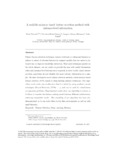Mostrar o rexistro simple do ítem
A scalable saliency-based feature selection method with instance-level information
| dc.contributor.author | Cancela, Brais | |
| dc.contributor.author | Bolón-Canedo, Verónica | |
| dc.contributor.author | Alonso-Betanzos, Amparo | |
| dc.contributor.author | Gama, João | |
| dc.date.accessioned | 2023-12-01T14:00:52Z | |
| dc.date.available | 2023-12-01T14:00:52Z | |
| dc.date.issued | 2019-11 | |
| dc.identifier.citation | Cancela, Brais, et al. «A Scalable Saliency-Based Feature Selection Method with Instance-Level Information». Knowledge-Based Systems, vol. 192, marzo de 2020, p. 105326. https://doi.org/10.1016/j.knosys.2019.105326. | es_ES |
| dc.identifier.issn | 0950-7051 | |
| dc.identifier.uri | http://hdl.handle.net/2183/34406 | |
| dc.description | © 2019. This manuscript version is made available under the CC-BY-NC-ND 4.0 license https://creativecommons.org/licenses/by-nc-nd/4.0/. This version of the article [Cancela, Brais, et al. «A Scalable Saliency-Based Feature Selection Method with Instance-Level Information». Knowledge-Based Systems, vol. 192, marzo de 2020, p. 105326] has been accepted for publication in "Knowledge-Based Systems". The Version of Record is available online at https://doi.org/10.1016/j.knosys.2019.105326. | es_ES |
| dc.description.abstract | [Abstract]: Classic feature selection techniques remove irrelevant or redundant features to achieve a subset of relevant features in compact models that are easier to interpret and so improve knowledge extraction. Most such techniques operate on the whole dataset, but are unable to provide the user with useful information when only instance-level information is required; in other words, classic feature selection algorithms do not identify the most relevant information in a sample. We have developed a novel feature selection method, called saliency-based feature selection (SFS), based on deep-learning saliency techniques. Our algorithm works under any architecture that is trained by using gradient descent techniques (Neural Networks, SVMs, …), and can be used for classification or regression problems. Experimental results show our algorithm is robust, as it allows to transfer the feature ranking result between different architectures, achieving remarkable results. The versatility of our algorithm has been also demonstrated, as it can work either in big data environments as well as with small datasets. | es_ES |
| dc.description.sponsorship | This research was financially supported in part by the Spanish Ministerio de Economía y Competitividad (research project TIN2015-65069-C2-1-R), by the Xunta de Galicia (research projects ED431C 2018/34 and Centro Singular de Investigación de Galicia, accreditation 2016–2019) and by the European Union (European Regional Development Fund) . We also gratefully acknowledge the support of NVIDIA Corporation with the donation of the Titan Xp GPU used for this research. Brais Cancela acknowledges the support of the Xunta de Galicia under its postdoctoral program. | es_ES |
| dc.description.sponsorship | Xunta de Galicia; ED431C 2018/34 | es_ES |
| dc.language.iso | eng | es_ES |
| dc.publisher | Elsevier | es_ES |
| dc.relation | info:eu-repo/grantAgreement/MINECO/Plan Estatal de Investigación Científica y Técnica y de Innovación 2013-2016/TIN2015-65069-C2-1-R/ES/ALGORITMOS ESCALABLES DE APRENDIZAJE COMPUTACIONAL: MAS ALLA DE LA CLASIFICACION Y LA REGRESION | es_ES |
| dc.relation.uri | https://doi.org/10.1016/j.knosys.2019.105326 | es_ES |
| dc.rights | Atribución-NoComercial-SinDerivadas 3.0 España | es_ES |
| dc.rights.uri | http://creativecommons.org/licenses/by-nc-nd/3.0/es/ | * |
| dc.subject | Feature selection | es_ES |
| dc.subject | Deep learning | es_ES |
| dc.subject | Saliency | es_ES |
| dc.title | A scalable saliency-based feature selection method with instance-level information | es_ES |
| dc.type | info:eu-repo/semantics/article | es_ES |
| dc.rights.access | info:eu-repo/semantics/openAccess | es_ES |
| UDC.journalTitle | Knowledge-Based Systems | es_ES |
| UDC.issue | 192 | es_ES |
Ficheiros no ítem
Este ítem aparece na(s) seguinte(s) colección(s)
-
GI-LIDIA - Artigos [64]






